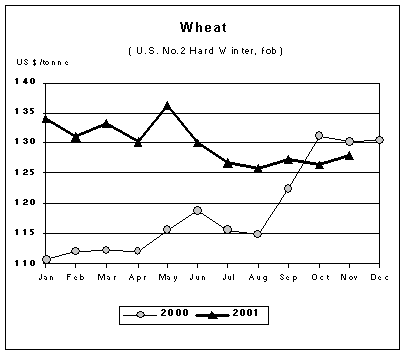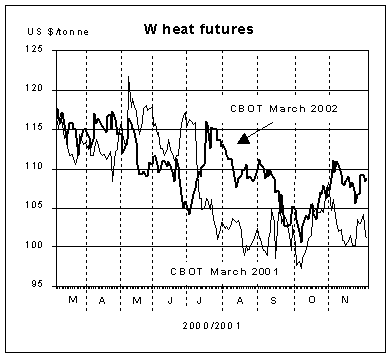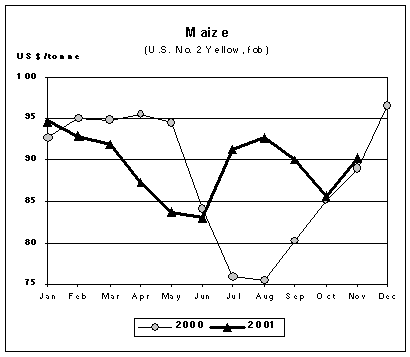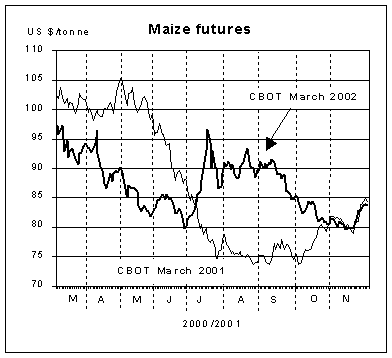International prices for most cereals changed little since the previous report. In November, the U.S. wheat No. 2 (HRW, fob) averaged US$128 per tonne, up slightly since September but some US$2 per tonne below November 2000. In recent months, wheat prices have fallen below the previous year's levels despite a decline in global wheat production this year. This could be explained by the existence of relatively large export supplies in a number of important wheat producing countries as well as the absence of any significant improvement in world import demand. Larger supplies of low-grade wheat from several origins have also contributed to the overall weakness in prices.
Wheat prices are expected to remain weak also during the second half of the current marketing season as supplies of new crops from Australia and Argentina begin to enter the market, adding to the downside momentum. Although wheat futures have been trading mostly above the levels registered in the corresponding period last year, the supply-side pressure continues to weigh on the market. By the last week in November, the March futures for the soft red winter wheat contracts at the Chicago Board of Trade (CBOT) lost some US$6 per tonne compared to the highs of around US$110 per tonnes in late October.
2001
|
2000
| ||
Nov.
|
Sept.
|
Nov.
| |
|
(. . . .. . US$/tonne . . .. . .)
| |||
United States
|
|||
Wheat
|
128
|
127
|
130
|
Maize
|
90
|
90
|
89
|
Sorghum
|
96
|
98
|
96
|
Argentina
|
|||
Wheat
|
109
|
119
|
128
|
Maize
|
93
|
88
|
85
|
Thailand
|
|||
Rice white
|
177
|
176
|
190
|
Rice, broken
|
136
|
151
|
130
|


International maize prices fell sharply between August and October, reflecting sluggish world import demand and large exportable supplies. In recent weeks maize prices began to rise while following closely last year's trend. The expected drop in maize production in the United States have been supportive to prices in recent weeks, and in November the U.S. maize export prices (U.S. No.2 Yellow, fob) averaged US$90 per tonne, up US$6 per tonne since October.

However, large maize inventories, on top of abundant supplies of feed wheat, will continue to weigh on prices. In addition, as with most other agricultural commodities, maize markets are also likely to be negatively affected by weaker demand as fallout of the global economic slow down. By late November, the March maize futures contracts at the CBOT were quoted at US$82 per tonne, slightly below the corresponding period last year.

The arrival of new rice crop on the market had a depressing effect on export prices and the FAO Rice Export Price Index fell by 1 percentage point to 88 in September and again in October, to 87. Prices held steady in November. The slide observed since September affected to the same extent high and low quality rice.
Among competing exporters, prices of the high quality Thai 100%B from Thailand have been sustained by steadfast import demand and the announcement of a resumption of Government procurement purchases. However, the retreat of African customers depressed prices of both the Thai A1 Super and parboiled rice in November. Viet Nam's rice quotations rose, but only because of the limited arrival of new supplies to the market in the wake of flooding in the Mekong Delta. Myanmar rice was also quoted higher in November. By contrast, Pakistan prices faltered as potential importers were discouraged by fears of delay in deliveries. Prices from India have also become particularly attractive, as supplies from the new crop have added pressure to the market. Reports of a record crop of long grain rice in the United States negatively influenced its prices. As a result, the price differential between the Thai 100%B rice and the US 2/4% long grain rice has narrowed to US$63 per tonne, compared with US$104 per tonne in January.
Seen from a longer time perspective, rice prices have been falling over the last twelve months by close to 10 percent, reaching their lowest level since 1987. The unabated slide has recently favoured the resurrection of a proposal to form an exporter alliance to prevent price undercutting, which will soon be considered by Thailand, Viet Nam, Myanmar and Pakistan.
A marked recovery in prices is not expected to take place during the rest of the year, since many countries will not come to the market to buy, having just filled their storage space with newly harvested rice. However, the price trend could turn positive as of next year, given the expected tightening of market conditions. On the one hand, several traditional exporters will face supply constraints. On the other, reduced inventories in a number of importing countries could boost import demand.